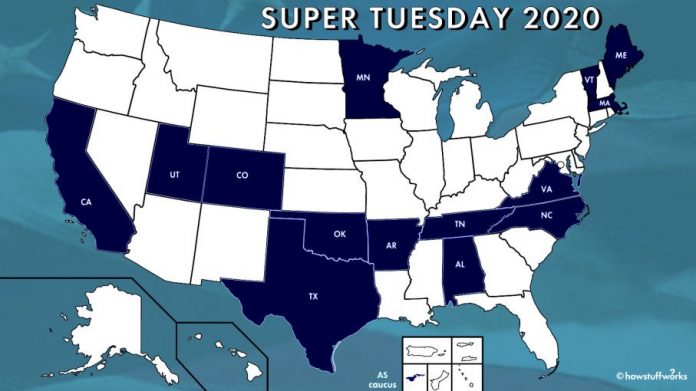To the relief of Democrats across the country, the South Carolina Democratic primary proceeded effectively and efficiently, both in terms of the voting process and the announcement of results, avoiding the delays of Nevada and chaos of Iowa caucuses.
With more than half a million voting (528,715 votes spread across 2,259 precincts), the most obvious result was that Joe Biden won a crushing victory, garnering nearly half of the vote in a still crowded field, leaving his competitors well behind, despite some recent polling that appeared to show a closer race. Bernie Sanders came in a distant 2nd, failing to breach the 20% mark.
Thanks to the 15% threshold rules, only Biden (41) and Sanders (13) earned delegates from South Carolina for the 2020 Democratic National Convention that will be held July 13-16, 2020, in Milwaukee, Wisconsin. Due to Biden’s wide margin of victory, he has essentially closed the delegate gap and has now surpassed all the other candidates in total votes from the first 4 Democratic contests. (see chart below)
| Candidate | Votes in South Carolina | % of SC vote | Delegates from South Carolina | Total Votes in first 4 DEM contests | Combined Delegates
(4 contests) |
| Joe Biden | 256,110 | 48.4% | 41 | 323,815 | 56 |
| Bernie Sanders | 105,225 | 19.9% | 13 | 268,276 | 58 |
| Tom Steyer | 59,916 | 11.3% | Has withdrawn | Has withdrawn | 0 |
| Pete Buttigieg | 43,612 | 8.24% | Has withdrawn | Has withdrawn | 26 |
| Elizabeth Warren | 37,352 | 7.07% | 0 | 111,351 | 8 |
| Amy Klobuchar | 16,678 | 3.2% | 0 | 103,950 | 7 |
For at least a few days, the Sanders momentum towards the nomination has been blunted.
Whether or not this will evolve into a competitive two-way race between him and Biden is unclear, as is the dwindling (though still theoretically possible) rise of another contender to challenge Sanders’ early frontrunner status.
With more than 50 states and territories left to contest, the path to earn the 1,991 delegates necessary to win the Democratic nomination remains a long and winding road.
However, on March 3 (aka Super Tuesday) there are 14 states in the mix (as well as American Samoa) comprising 1,357 delegates up for grabs (~34% of the overall total).
Regardless, this was a dramatic demonstration of resilience from a Biden campaign that many had counted out in the wake of dismal performances in Iowa and New Hampshire and a distant 2nd-place in Nevada.
But finally, Joe Biden has something to cheer about, and perhaps to leverage. Until this weekend, Biden had never won a presidential primary contest: he dropped out well before voting started in the 1988 cycle, and in 2008 exited after the Iowa caucuses.
Clearly, this was the scale of victory that Biden required in order to the reboot his campaign heading into Super Tuesday. But will South Carolina serve as a turning point in a thus far lackluster campaign, or merely a bump in the road for the Sanders express?

While the timing is beneficial for Biden, it still might be too little too late, given the short window between the South Carolina results and the vote on March 3.
With Super Tuesday a scant 2 days away, there it is logistically impossible to generate and execute a massive advertising campaign that incorporates/capitalizes on the Biden victory (or the Sanders loss).
Moreover, any new narrative will not affect the large number of Super Tuesday voters who have already turned in ballots. Massive numbers of voters in delegate-rich states like California and Texas began voting well before these results were known.
According to Political Data Inc., more than 1.4 million Democrats have already voted in California (by far the biggest prize of the entire nomination process with 415 delegates).
The upside is that this represents only about 20% of all ballots mailed, and according to Political Data Inc. there is some evidence to suggest that significant numbers of California voters have been holding onto to their ballots and waiting, a group that includes so-called high-propensity voters (those who can be counted on to vote in primaries).
Thus, while South Carolina’s returns will give Biden a major boost, it will not make a difference for the multitude of voters who have already turned in their ballots.
How the Primary Played Out in South Carolina
But first things first. Biden got the massive win that he needed, outperforming both his rivals and the polls. Taking ¾ of the delegates in South Carolina, Biden has not only closed the delegate gap, but he has outpolled all the other contenders in raw vote totals.
But beyond the specific vote totals, what does Biden’s performance in South Carolina tell us about the race? The Biden coalition in the Palmetto state comprised 3 essential constituencies: African-American voters, moderates, and older voters (beyond the age of 45).
In both 2008 and 2016, African-American voters were a massive factor in the Democratic presidential primaries. Blowout victories in South Carolina by Barack Obama in 2008 and by Hillary Clinton in 2016 were early signposts for the eventual winning path.
While the far more fractured field of 2020 calls into question the degree to which South Carolina will be predictive of the eventual victor, there are an abundance of positive dynamics for Joe Biden that were revealed in the voting patterns on February 29.
For example, an important storyline in Sanders’ blowout win in Nevada was that he was able to eat into Biden’s strength with African-American voters. However, Sanders was unable to reprise that feat in South Carolina, where African Americans comprised over 56% of the electorate.
Biden won this demographic by 44 points over Sanders (61%-17%). Thus, the South Carolina vote showed that Senator Sanders has yet to win the support of the Democratic Party’s most loyal constituency. A caveat here, Sanders has recently polled better among African-American voters nationally, so South Carolina could either be an outlier or a harbinger.
Meanwhile, the weakness in this demographic among Buttigieg, Warren, and Klobuchar was even starker than in the past, as each failed to reach double digits among African-American voters, though perhaps Tom Steyer pulled away some of those voters from them.
While Steyer and Buttigieg has now dropped out, none of the other 2 have provided any electoral evidence that they can build a diverse coalition behind their candidacy. A crucial factor in Biden’s robust performance in this key demographic was the result of the last-minute, and high profile, endorsement by House Majority Whip James Clyburn, who is an ‘institution’ in both South Carolina politics and the African-American Congressional Caucus.
In voter replies and conversations with those conducting exit polls, Clyburn’s endorsement was frequently mentioned. When he spoke on behalf of Biden, Congressman Clyburn made a simple yet persuasive case for the former Vice President, saying: “I know Joe. We know Joe. But more importantly, Joe knows us.”
Clyburn’s influence in South Carolina goes well beyond the African-American community, and he is particularly well regarded by moderate Democrats, which is also a critical demographic for Democrats in the general election.
While much ink has been spilled about Bernie Sanders’ appeal with the more progressive and radical wings of the Democratic Party, moderates still occupy a large and essential place within its electorate. For any candidate to defeat Bernie Sanders for the Democratic nomination (and defeat Trump in the general election), he or she needs to both expand and dominate the moderate voter demographic.
Approximately half of the voters who cast ballots in the South Carolina Democratic primary described themselves as either conservative or moderate. By contrast, that figure for the contests in Iowa, New Hampshire, and Nevada, was only about 1/3 of the vote, with liberals in those 3 contests comprising 2/3 of the electorate. Exit polls found that in South Carolina, Biden beat Sanders in this category by a landslide (59%-12%).
Another strength on display was Biden’s robust performance with older voters (over age 45), a demographic where Sanders is probably at his weakest. Indeed, a large part of the Sanders’ narrative is his popularity with young voters, as well as his purported ability to churn out new voters.
While much has been made of this, the good news for Biden is that the over-45 electorate is larger than the under-45 electorate. Moreover, the Sanders magic seems to have faded in the Palmetto state, in that the his campaign was unsuccessful in turning out young voters or new voters. Only 11% of the electorate on Saturday was under 30 and just 19% were first-time voters.
Meanwhile, the Sanders team faced another unwelcome surprise: Biden’s performance was so thorough in South Carolina that even voters who consider themselves “very liberal” chose him over Sanders by 15 points (44% to 29%), while Biden’s margin was even wider among those who deem themselves “somewhat liberal” (44%-23%). This is Sanders’ ‘bread and butter’, so these results might allow the Biden campaign to hold out at least some hope that Biden could make inroads into the Sanders base.
What About the Rest of the Field?
Whether the Democratic nomination is poised to become a 2-candidate race is now the main talking point for many pundits. The key question — and honestly, nobody knows the answer — is how much this result changes the race overall on the brink of Super Tuesday.
But another part of Saturday’s story was how the other Democratic candidates would fair in South Carolina. The short answer is, not very well. Of South Carolina’s 46 counties, only a dozen have populations in excess of 150,000, and Biden and Sanders dominated in all of them. In fact, Biden won all 46 of the state’s counties. [see chart below]
| County | Popul. | Top 4 Finishers |
| 1: Greenville | 498,402 | Biden: 38.16% Sanders: 24.72% Steyer: 10.67% Buttig: 10.51% |
| 2: Richland | 408,263 | Biden: 51.91% Sanders: 17.66% Steyer: 12.32% Warren: 8.13% |
| 3: Charleston | 394,708 | Biden: 44.30% Sanders: 19.17% Buttig: 12.65% Warren:10.85% |
| 4: Horry | 320,915 | Biden: 43.82% Sanders: 22.29% Steyer: 12.67% Buttig: 9.49% |
| 5: Spartanburg | 302,195 | Biden: 42.28% Sanders: 24.87% Steyer: 12.35% Buttig: 7.86% |
| 6: Lexington | 286,316 | Biden: 39.86% Sanders: 23.60% Steyer: 11.61% Buttig: 10.57% |
| 7: York | 258,641 | Biden: 43.61% Sanders: 24.70% Buttig: 11.72% Warren: 8.71% |
| 8: Berkeley | 209,065 | Biden: 49.08% Sanders: 21.34% Steyer: 9.42% Buttig: 8.34% |
| 9: Anderson | 195,995 | Biden: 41.82% Sanders: 23.50% Steyer: 13.56% Buttig: 7.43% |
| 10: Beaufort | 182,658 | Biden: 45.81% Sanders: 15.30% Buttig: 12.38% Steyer: 12.33% |
| 11: Aiken | 166,926 | Biden: 44.81% Sanders: 20.99% Steyer: 13.15% Buttig: 8.25% |
| 12: Dorchester | 155,474 | Biden: 47.55% Sanders: 21.70% Steyer: 9.37% Buttig: 9.05% |
Despite his 3rd-place finish, perhaps the biggest loser in South Carolina was billionaire businessman Tom Steyer, who spent over $22 million on television and radio ads in the state attempting to cut into Joe Biden’s core voting blocs there.
Like Biden, Steyer had put most of his chips on South Carolina, but where Biden flourished Steyer could simply not break out of the 2nd-tier pack. As a result, he decided to drop out of the 2020 presidential race, admitting that he couldn’t see a “path where I can win.”
According to data from Kantar Media’s Campaign Media Analysis Group, Steyer spent an estimated $150 million on TV ads since entering the Democratic race in last summer. This includes the approximately $60 million that he sunk into advertising in the upcoming Super Tuesday states.
Of course, according to Forbes he has an estimated net worth at $1.6 billion to fall back on, so he’ll be fine. Prior to his foray into electoral politics, Steyer was a prominent funder of liberal causes as well as the financial force behind many Democratic political candidates. The party faithful hopes that he will return to the role of financier of liberal causes and candidates in time to help defeat Donald Trump.
Meanwhile, in the wake of Biden’s political resurrection, the respective campaigns of Amy Klobuchar, Pete Elizabeth Warren, and Michael Bloomberg have all told reporters that they are closely studying their path forward towards the nomination.
Given that none of them has yet to show an ability to diversify and expand their limited support, pressure on them to drop out will certainly intensify. Pete Buttigieg and Amy Klobuchar were non-factors for a second straight contest, in great part due to their inability to broaden their voting coalition to include minority voters. That is a fatal flaw in South Carolina.
Along with Senator Warren, both Buttigieg and Klobuchar dealt with lower levels of familiarity among Democratic voters and significant questions about their records on race. According to a Quinnipiac poll in February 2020, Warren had only 8% support nationally among African-American voters, while Buttigieg had a mere 4% and Klobuchar didn’t even have enough support to register. This raised serious questions about their broader electoral viability, not only within the Democratic primaries, but also in the general election.
After the South Carolina results, senior campaign aides for Pete Buttigieg privately acknowledged that they did not expect to win any of the states being contested on Super Tuesday. Initially, they opted for a new strategy of simply aiming to reach the 15% viability threshold in some key districts in order to garner at least some delegates. But the writing was already on the wall, as the former Mayor of South Bend, Indiana, saw his already narrow lane closing ever faster now that Biden is resurgent.
At 38, he was by far the youngest candidate, but ironically could not connect with the younger voters, who tended to gravitate to 78-year old Senator Bernie Sanders. As a former Navy intelligence officer who served in Afghanistan, and as a Rhodes Scholar with degrees from Harvard University and the University of Oxford, he speaks multiple languages and had the highest academic credentials. But he simply could not broaden his base. Rather than continuing to campaign,
Buttigieg has announced that like Tom Steyer, he will also end his 2020 presidential campaign. As the country’s first openly gay presidential candidate to rise to major-candidate status, he has opened doors. Buttigieg’s support spans the ideological length of the party, so it is not entirely obvious who would benefit most if/when he drops out.
With only limited appeal and depleted funds, Senator Amy Klobuchar had effectively abandoned South Carolina days before the primary, embarking upon campaign stops in North Carolina, Virginia, Tennessee, and Maine. Her campaign claimed that it was planning to spend $4.2 million on advertisements in Super Tuesday states, though her most likely prize that day would have been her home state of Minnesota (75 delegates), but even that was not assured.
On Monday she announced that she would end her campaign, replicating that decisions of Pete Buttigieg and Tom Steyer made following their disappointment in South Carolina.
Aside from a surprise 3rd-place finish in New Hampshire, she was 5th in Iowa, and 6th in both Nevada and South Carolina, with absolutely no sign of broadening her support.
Both she and Pete Buttigieg have now endorsed Joe Biden, moves that must delight the moderate wing of the Democratic Party. Perhaps the last gasp of her 2020 Presidential bid will be if she can deny Bernie Sanders’ a victory in her home state of Minnesota, which would certainly be a benefit to the Biden campaign.
Throughout the primaries, Elizabeth Warren has portrayed herself as the only candidate of the pack who can unite the Democratic Party’s ideological factions. She is a popular figure with many Democratic pundits and leaders, but she has been unable to translate that into a reliable base of electoral support.
She enters Super Tuesday without a top-2 finish in any of the initial 4 electoral contests. Her 5th-place showing in South Carolina (barely 7% of the vote) took the wind out of any arguments that her strong debating performances have increased her appeal, at least with primary voters. Nonetheless, she continues to claim that her campaign is “built for the long haul.”
In addition to campaigning in Super Tuesday states, she will be appearing in Michigan, which holds its primary on March 10. Like Klobuchar, she is struggling to defend her own home state (Massachusetts) against Bernie Sanders, who is pressing both candidates hard at home.
That neither Senator Klobuchar nor Senator Warren are safe bets in their home states does not augur well for their nationwide viability arguments. On a more positive note, thanks to recent fundraising surge Warren will not be running out of money anytime soon. Thus, she can now afford to see how Super Tuesday pans out, and move forward to the subsequent primaries.
With Buttigieg, Klobuchar, and Steyer now dropping out, she might be able to scoop up some of their supporters, though those voters leaned in a direction that is more moderate than Warren has portrayed herself.

Super Tuesday contests and # of delegates at stake: Alabama (52); American Samoa (6); Arkansas (31); California (415); Colorado (67); Democrats Abroad* (13); Maine (24); Massachusetts (91); Minnesota (75); North Carolina (110); Oklahoma (37); Tennessee (64); Texas (228); Utah (29); Vermont (16); Virginia (99).
Even though he was not on the ballot, former New York City Mayor Mike Bloomberg was another casualty of the Biden resurgence. The best case for Bloomberg has always been a scenario in which he is viewed as the lifeline for centrists who strive to defeat Bernie Sanders.
That picture is most plausible if Sanders is the undisputed front-runner and moderates are hopelessly split among several semi-viable candidates. Bloomberg’s entrance into the Democratic race was predicated upon a belief that Biden was fatally weak and that nobody else could stop Sanders.
Based on this political vision, Bloomberg has spent over $500 million in an attempt to leapfrog the initial primaries and emerge as a major candidate on Super Tuesday, when he’ll be on the ballot for the first time.
But Biden’s massive win in South Carolina, coupled with back-to-back weak debate performances by Bloomberg, throws such calculations into disarray. Now that Biden has finally won a state, and done so quite spectacularly, we could see a return to the fold of ‘Bloomberg-curious’ voters who drifted away from Biden when he looked down and out.
As the 2nd-tier moderates seem to be underperforming and hence likely to fade away faster than Bloomberg expected, the new dynamics of the race begs basic questions about his candidacy.
If Biden can capitalize on South Carolina to get through Super Tuesday with some momentum, and show evidence that he can build the diverse coalition that Democrats need to retake the White House, it will be difficult for Bloomberg to argue that Biden is not electable.
Competing with a resurgent Biden without other moderates stripping away potential Biden supporters will be tough sledding for Bloomberg. Of course, if Biden falters badly on March 3rd, and Bloomberg can somehow net a substantial number of delegates, the narrative shifts again.
Which brings us back full-circle, to Bernie Sanders, who is still favored to win in delegate-rich Super Tuesday states like California (415 delegates). However, a Democratic nomination that some lamented (or cheered) as seemingly a foregone conclusion only a week ago, now has the potential to develop into a competitive race.
Biden’s big win in South Carolina could generate momentum in other key states up for grabs on Tuesday, such as Virginia (99 delegates) and North Carolina (110 delegates).
And could Biden’s resurgence wash away Sanders’ heretofore narrow lead in Texas (228 delegates)? Substantial African-American voting blocks in Tennessee, Alabama, and Arkansas also play into Biden’s favor. If Klobuchar and Warren continue to underperform with this demographic, and outperform in Minnesota (75 delegates) and Massachusetts (91 delegates), respectively, the so-called Sanders’ juggernaut could be contained.
Is Biden still the underdog on Super Tuesday? Yes, but less so than he was last week. But given his sluggish start, Biden has a great deal of ground to make up. Ominously, he is being monstrously outspent on the airwaves in the 14 Super Tuesday states, and he has fewer staffers organizing on the ground than Bernie Sanders does.
Add to that Sanders’ demonstrated strength with Latino voters, who comprise significant voting blocs in California, Texas, Colorado, and even Utah. The Sanders’ campaign is spending 25 times what Biden is in Super Tuesday states — $15.5 million to $600,000, according to Advertising Analytics. In fact, Biden spent more on ads in South Carolina ($1 million) than across all of the 14 Super Tuesday states.
| State | # of delegates | White | Hispanic | African-American | Asian | Voted for in past 3 General Elections |
| California | 415 | 37.0% | 39.1% | 5.5% | 14.4% | 2008 Obama 61.01%
2012 Obama 60.24% 2016 Clinton 61.73% |
| Texas | 228 | 41.9% | 39.4% | 11.8% | 4.8% | 2008 McCain 55.45%
2012 Romney 57.17% 2016 Trump 52.23% |
| Colorado | 67 | 68.2% | 21.5% | 3.9% | 3.1% | 2008 Obama 61.80%
2012 Obama 53.66% 2016 Clinton 48.16% |
| Utah | 29 | 78.3% | 14.0% | 1.2% | 2.4% | 2008 McCain 62.58%
2012 Romney 72.79% 2016 Trump 45.54% |
Whether Biden has derailed the Sanders Express or merely delayed it, remains unclear. For the first time in the 2020 campaign season, moderate and conservative Democrats voted with something that resembled a unified voice.
While this group has actually comprised a majority of voters in previous primaries, its strength was diluted by splitting votes among a number of candidates. The post-Nevada Sanders ‘surge’ might have been the wake-up call that Party leaders have hoped for.
If a large swathe of Democratic voters are actively looking for alternatives to Bernie Sanders — but just have not been certain about which choice is best — then the Biden resurgence could have a larger impact on the race than the result of one primary.
Biden’s strong finish in South Carolina, along with improved debate performances, endorsements, and increasingly favorable media coverage, and a strong showing on Super Tuesday, could convince such strategic voters that Biden is the best alternative to Sanders.
This of course assumes that the moderate vote is both substantial and coherent, and that it could consolidate behind one alternative. In New Hampshire, voters flocked to Pete Buttigieg and Amy Klobuchar in the closing days of the campaign, and away from Biden and Elizabeth Warren. Could they now move in the opposite direction? We should have a better idea by Wednesday.









